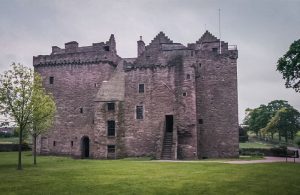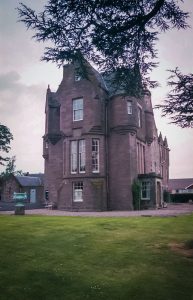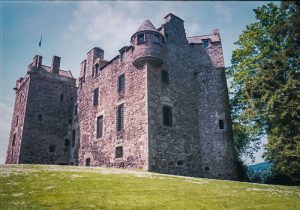t h u r s d a y m a y 2 7 1 9 9 9
Huntingtower Castle is accessible by driving through someone’s farm, around the barn, a couple of sheds, and then down a tiny farm track that wound it’s way around to the site of the castle. We arrived just before a group of school busses, but they couldn’t negotiate the road down and had to walk.
This is an interesting tower house, since it really is two independent tower houses that were connected later. We’re not sure why — it may have been the solution to two sons needing their own households, or some sort of disagreement.
Between the two towers is a gap (now filled in with a central hall and stair) that is called “The Maiden’s Leap”. The daughter of the lord was apparently visiting her lover in the other tower when she heard her mother’s footsteps on the tower stairs. Panicking, she ran to the battlements and leapt across the 10’+ gap to her own rooms in the other tower to avoid detection. She and her lover eloped the next day, but it’s an exciting story.

Huntingtower is in good shape, and inside there are some amazing painted ceilings in a number of the rooms. Most are faded, and many were plastered over, but you can just imagine the intricately painted and decorated ceiling beams in these great halls, tapestries on the walls, full of people. Other walls reveal traces of the painted plaster, murals and geometric patterns, that are still visible. The tower has been well maintained, since it was used to house day laborers up until quite recently. The stone slab roof may date from the 1600s, but we weren’t able to determine that for sure. The grounds are much reduced, and expanses of farmland now surround the walled courtyard.
 We drove through Perth, which is a really pretty town, in search of The Black Watch Regimental Museum, which is housed in the well-restored Balhousie Castle. The Black Watch, which is recognized the world over by their distinctive tartan pattern, is either named for that dark sett, or the name is a reference to their formation to spy on the Jacobites. Black in Gaelic is dhu, which also means hidden or covert. The museum is very interesting, with rooms on each floor dedicated to the many wars fought by the Black Watch and the illustrious history of the regiment.
We drove through Perth, which is a really pretty town, in search of The Black Watch Regimental Museum, which is housed in the well-restored Balhousie Castle. The Black Watch, which is recognized the world over by their distinctive tartan pattern, is either named for that dark sett, or the name is a reference to their formation to spy on the Jacobites. Black in Gaelic is dhu, which also means hidden or covert. The museum is very interesting, with rooms on each floor dedicated to the many wars fought by the Black Watch and the illustrious history of the regiment.
Balhousie is not really a castle, but it a mansion built around a 16th century towerhouse. It was apparently a common occurrence to design late 19th century mansions in the style of old castles. It does not have thick walls or gates.
Off to Scone Palace, home of the Stone of Scone, which is where all the Scottish kings have been crowned. This was probably the most tourist-y of the places we’ve been so far, we had to fight for parking spaces with the huge number of tour buses, and then follow the hordes of people as they wandered through the museum floor. We spent most of our time looking at the peacocks that roam around the grounds. It was apparently mating season, and the peacocks were trying to attract the attention of the peahens. I’d never seen a peacock up close with their tails all unfurled. It’s pretty spectacular.

The building is not that old, but it is large and still houses the family on the upper floors. In late summer, the vines that cover the stone walls bloom red. In the grounds is the Chapel on Moot Hill, which is where the Stone of Scone is kept. Rumor has it that this is not the real stone, the real one being stolen by the English and only recently returned to sit in Edinburgh. However, a competing rumor says that this is indeed the real stone, which was carefully hidden by the monks when they heard of the plan to steal it, and then placed here, where it has remained since 1296. Who knows.
I was not that impressed with Scone Palace. It was way too commercial, and seems to cater to the tourist groups who want to ooh and aah over replicas of famous stuff — like the replica Crown Jewels and swords. Everyone is funneled through the first floor by red velvet ropes, and you can’t touch anything at all. Interesting, but certainly not worth the price of admission, if you ask me.
The sun finally came out in earnest, and the day was turning out beautifully. Our next stop was Elcho Castle, a well preserved z-plan tower outside of Perth. This tower is large, and sports the unique accessory of metal grates over most of the windows. The large gun holes on the first floor also support the impression of Elcho being very secure. Down below the castle lies a deep grotto, which is now finished as a small garden. However, the caretaker told us that it was at one time a private boat launch, filled from the nearby loch. The loch is now far away, and certainly too low to ever fill this area, but it was probably lowered some time ago (like Loch Leven). The castle would have been easy to defend from this position.

Inside, there are bits of the original plaster walls and crown moldings in some of t he rooms. A few painted ceilings also remain. Elcho Castle is in excellent condition after restoration work in the 1830s. It was still in use in the 1780s, but then de-roofed and abandoned.
We headed up the coast to Montrose and stayed in the Carlton Hotel. Montrose has the faint luster of a second-hand, dying town that is just trying to stage a comeback. It’s a bit rough on the edges still, and most of the shop fronts are either closed up or boarded over. They are repaving the main road, which probably accounts for some of the shabbiness. This is the first place we’ve stayed where I was concerned about locking the car and hotel door.
Luckily we found shutters on the windows, or we’d have had to sleep in the half-light of summer nights (it stays light out until 11 or so and is twilight-ish again by 2). We just had dinner in the bar (fried foot again, but quite good) and went to bed. It wasn’t really that bad — just a bit run down and not up to the standards of the other hotels we stayed at. But it was clean, and the people were friendly and you could tell they really liked dealing with visitors.
